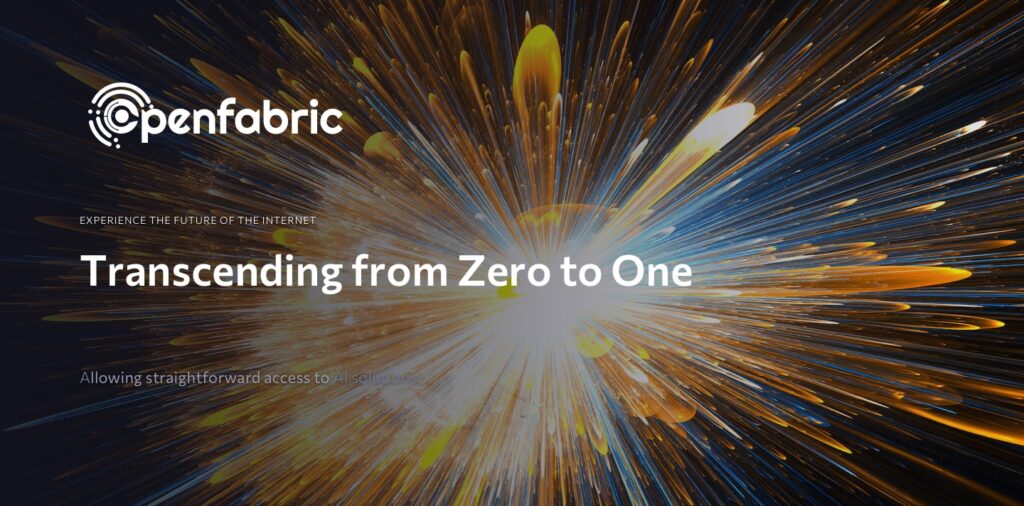
March 1, 2022 5 minutes read
Transcending from Zero to One – Openfabric AI’s Development

Conventional growth models have no doubt led humanity to great discoveries within a short span of time. However, the disastrous consequences of mankind’s rapid progress are being witnessed today in the form of climate change and air pollution. The challenges of our present and our future require something out of the ordinary. In other words, Openfabric AI.
Today – as we are in the post-globalization era – the time when merely copying ‘things that work’ meant success is far behind us. As opposed to the traditional, horizontal progress, today’s technological change translates into vertical progress. It is precisely this momentous leap that we call moving from zero to one.
Simply put, startup thinking is the only way in which this jump from zero to one is possible. As Peter Thiel famously put it, ‘A startup is the largest group of people you can convince of a plan to build a different future. A new company’s most important strength is new thinking: even more important than nimbleness, small size affords space to think.’
End of the “economies of scale”
During the last few centuries, the prevailing mantra has been that of bigger is better. Small companies had little to gain while the surefire way to success was seen as rapid expansion and scaling to an enterprise of massive magnitude.
With the uberization model, this approach got a massive hit. The economies of scale gave way to a more efficient means of doing business. Now we have the world’s largest ride service that does not own its fleet of cars as well as the largest house renting service that operates all over the world yet owns no property of its own. This unscaled economy is paving the future for entrepreneurs and dreamers.
It is not hard to see how successfully technology and artificial intelligence has worked. It has reduced inefficient, bloating organizations with intelligent services that address the pain points of their consumers. This is one of the ways technology has evolved from zero to one and finding relevance in our society.
Power of exponential technology
Exponential technology has the power to totally redefine history. Throughout the course of human history, major turning points like the agricultural revolution and the industrial revolution have brought about a massive change in the way of life. Now, it is becoming clear that the challenges of today can only be solved through exponential technology.
The Web 3.0 movement is already gaining momentum. Blockchain solutions are emerging and being made more efficient. The technological shift has already started. It has the potential to develop existing financial systems, health care, education, entertainment, and every sphere of life.
Our future may look very different from what we are used to today. Exponential technology has the power to shape a new and better world that is free from the issues that affect our lives today.
Is the singularity inevitable?
Singularitarians like Ray Kurzweil picture a future that is totally shaped by advanced technology that defies our current understanding. The journey that started with Moore’s Law is nearing its logical conclusion. As per Kurzweil, this singularity with artificial intelligence of superhuman proportions is inevitable. All he suggests we can do is to prepare for it.
In the end, the fact remains that we can not predict any future trends with absolute confidence. Although, the singularity may not be as absolute as the imagined merging of machines and humans. We, on the other hand, have to work on creating technologies that shape our world for the better.
Doing nothing is not an option here. The first step to progress is to think. Once we embark on this journey of progress, we can come up with new things that will define a new and better tomorrow.
The way forward with Openfabric
With all this talk about radical new technologies and the internet full of new buzzwords that drop clearly out of nowhere, it is easy to get tired. Most people realize the importance of the new technological shift that is taking place and want to pitch in. However, they often find it difficult to find a worthy project to get behind.
Openfabric realizes this and has set out on a mission to democratize artificial intelligence for the masses. It not only reduces the barrier to entry but also provides a wide array of powerful, intelligent tools and products. These tools and products empowers its community to become a valuable part of the next wave of technological advancement.
Another key issue with current technology is that the key drivers have been the large companies like Google, Amazon, Facebook, and Apple. These big technology companies control a large part of the industry and push their own services as the only viable solution. Openfabric is set to truly bring the power of artificial intelligence to the hands of the consumer and provide a truly decentralized infrastructure.
Whom is Openfabric for?
The Openfabric platform is not just for business users but in fact, we have something for everyone. Some of the key stakeholders of the system are categorized as follows:
Service consumers are the end-users who require the power of artificial intelligence to solve specific problems or improve their service offerings with data-driven intelligence. The learning curve for service consumers is low and they can enjoy seamless access to performant AI tools without the technical know-how typically required to use and train AI applications.
AI innovators can be defined as the creators of AI programs. Creators are incentivized to use their expertise to create elaborate, practical AI algorithms that can solve complex real-world problems.
Infrastructure providers help provide the various hardware capabilities and the decentralized network required to run and train AI applications.
Data providers help provide the vast amounts of data that is required to train and test AI algorithms. Companies that possess consistent datasets can profit by licensing this data on the platform for use by innovators and data providers.
You can learn more about the Openfabric platform on our website. For an in-depth analysis, you can read our whitepaper or a summary in the form of a litepaper.

